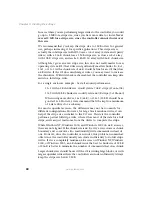
20
Chapter 3: Creating Disk Arrays
www.gateway.com
Initialization
RAID 5/50 arrays must have consistent parity before they
can be used to protect data. Initialization writes a known
pattern to all drives in the array. If you choose not to
initialize an array, this is known as a “trusted array” and
any drive failure will result in data corruption. It is possible
to later perform a parity rewrite, which recalculates the
parity based on the current data, thus ensuring the data
and parity are consistent.
Reserved Capacity
In order to allow drives from a different family or
manufacturer to be used as a replacement for a drive in
an array, we recommend that a small percentage of the
drive’s capacity be reserved when creating the array. This
is user selectable, from 0 to 10 percent.
RAID Level 0
RAID 0 is defined as disk striping where data is striped or
spread across one or more drives in parallel. RAID 0 is
ideal for environments in which performance (read and
write) is more important than fault tolerance or you need
the maximum amount of available drive capacity in one
volume. Drive parallelism increases throughput because
all drives in the stripe set work together on every I/O
operation. For greatest efficiency, all drives in the stripe set
must be the same capacity. Because all drives are used
in every operation, RAID 0 allows for single-threaded I/O
only (i.e., one I/O operation at a time). Environments with
many small simultaneous transactions (e.g., order entry
systems) will not get the best possible throughput.
RAID Level 1
RAID 1 is defined as disk mirroring where one drive is an
exact copy of the other. RAID 1 is useful for building a
fault-tolerant system or data volume, providing excellent
availability without sacrificing performance.
RAID Level 5
RAID 5 is defined as disk striping with parity where the
parity data is distributed across with parity all drives in the
volume. Normal data and parity data are written to drives
in the stripe set in a round-robin algorithm. RAID 5 is multi
threaded for both reads and writes because both normal
data and parity data are distributed round-robin. This is
one reason why RAID 5 offers better overall performance
in server applications. Random I/O benefits more from
RAID 5 than does sequential I/O, and writes take a
performance hit because of the parity calculations. RAID
5 is ideal for database applications.
Содержание 840 VT-100
Страница 1: ...Gateway 840VT 100 User s Guide Installing Getting Help ...
Страница 5: ...iv ...
Страница 9: ...4 Chapter 1 Introduction www gateway com ...
Страница 21: ...16 Chapter 2 Accessing the Configuration Utility www gateway com ...
Страница 147: ...142 Chapter 6 Advanced Configuration and Management www gateway com ...
Страница 177: ...172 Chapter 8 Statistics www gateway com ...
Страница 241: ...236 Appendix B www gateway com ...
Страница 249: ...244 8509736 ...
Страница 250: ...A MAN NSTOR VT 100 SW GDE R0 1 04 ...






























